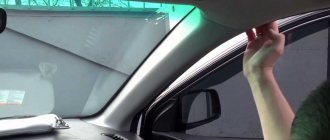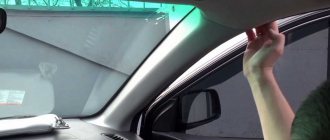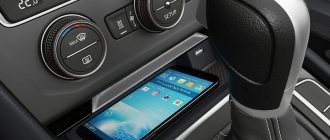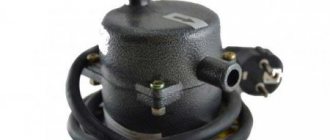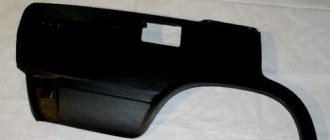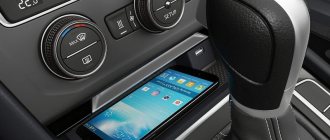Do you need underbody lighting?
The LED underbody does not provide any benefit or practical purpose to the driver. Its main goal is to attract the attention of others so that other car enthusiasts admire the work of the master. If you look at this creative from the other side, then with the help of lighting you will be able to quickly find dropped keys or a wallet.
Unfortunately, traffic police officers also pay attention to original cars. You need to understand that they will definitely stop the driver of such a car and ask to show documents.
Rules for installing LEDs
The first thing you need to immediately understand is that an LED is not a lamp. You must be careful and careful during the replacement procedure. Repairing the electrical part of a car due to incorrect actions is not a pleasant thing. However, there is nothing complicated in such a replacement; LEDs for a car, the tuning of which you have already thought about, can be installed yourself.
Voltage and current are two fundamental characteristics. In the car's on-board electrical network, the voltage is usually 12-13 V when the engine is off, and when the engine is running - 13-14.5 V. The supply voltage for our lamps ranges from 2-3.8 V depending on the color (to be confirmed with the manufacturer). The current value for a low-power lamp is limited to 20 mA, high-power LEDs reach 350 mA.
It is also necessary to take into account that not all LEDs can illuminate the space around them. When buying new lamps, pay attention to the type of lens, which indicates the dispersion angle. For example, narrow-beam light bulbs have a small lens.
Allowed or not?
Many drivers do not know whether installing underbody lighting is legal. They are also interested in what fines may be imposed on the owner. Of course, many motorists claim that they have not had any conflicts with traffic police officers over the lighting. But sometimes such tuning is assessed as a deliberate change in the design of the car.
Unfortunately, the law does not have a specific clause on which there are requirements regarding lighting. The driver has the right to make adjustments only after permission from the State Inspectorate, but only if they affect the functioning of the car.
It is believed that if the backlight is installed according to the rules, then no sanctions will be imposed on the driver. Otherwise, a traffic police officer may regard the tape as a device that “illegally” transmits a light signal. In this situation, the driver will be deprived of his license. An additional fine of 3,000 rubles is imposed.
Kinds
Today, lighting for cars is created on the basis of LED strips. They do not heat up, do not fade and shine brightly. Ribbon is available in a variety of colors and shades. If desired, car enthusiasts can install RGB backlighting to control the glow themselves.
In addition to LED strip, the use of neon lighting is allowed. Unfortunately, it is not very popular due to installation difficulties. It is easy to damage. Most often, this option is installed on exhibition models of cars that are not planned to be used.
Additional LED lighting options
In addition to interior design, illumination of the underbody of the car has become widely popular. An LED or neon strip installed under the body creates a “floating” effect and turns an ordinary car into a brutal and stylish car. In addition to illuminating the underbody, many car enthusiasts decorate other areas:
- wheel arches;
- headlights, taillights;
- trunk;
- radiator.
Different lighting options are used - the backlight blinks, changes color, and creates the effect of running or multi-colored lights. At the same time, you should not overload the car with lighting effects, otherwise it will look ridiculous, irritate spectators and attract the attention of traffic police officers.
Neon lighting consists of linear lamps. They are fragile, have low brightness, and are quite expensive. The only advantage is the possibility of directional illumination, the formation of a focused light strip. Unlike neon, LED lighting is resistant to mechanical stress, durable, unpretentious and produces bright light in different shades. Installation of LED strip is much easier and faster, and the price is noticeably lower. All these benefits determine the demand and preference of users.
Design methods
When installing lighting, a motorist can choose one of several options. Let's list them:
Direct connection. The lighting device is connected to the car's electrical network.
Flicker. To create a flashing light, a controller with a specific function is used.
Remote. To control the backlight, the driver uses the remote control or a button on the instrument panel.
Autonomous operation. The operation of the lamps does not depend on the car's electrical network.
The car enthusiast can choose one option, or several at once. It depends on personal preference.
Why do you need a dimmer?
This device is analogous to a conventional switch. Its distinctive feature is the smooth switching on and off of the light source. This scheme has been successfully used in car interiors for some time now. Moreover, due to its small size, the device can be easily placed not only inside the lampshade, but even hidden in the casing.
The dimmer has the following advantages:
- after closing the doors, the interior lighting dims and turns off smoothly within 10 seconds;
- The duration of the smooth shutdown itself is 8 seconds;
- When the engine starts, the light goes out automatically;
- After opening the doors, the lighting turns on and remains in this state for 7 minutes.
The light begins to glow when the voltage of the vehicle's on-board electrical network changes. This process is controlled by the ADC of the microcontroller, which monitors the readings of the generator reverse current relay.
For example, if the voltage is less than 13.6 Volts, then this indicates that the engine is turned off. With high readings of this parameter, the machine operates.
“Smart light” is perceived positively psychologically and does not tire the eyes, since there is no sudden switching on of the light immediately after closing the car doors. The smooth operation of the lighting device is ensured by a special electronic board, which is mounted in the electrical circuit of the car interior.
detailed instructions
Do-it-yourself installation of underbody lighting should begin with electrical work. First, you will have to develop an electrical circuit for all LED segments and test it for functionality. There are several connection methods: parallel and serial. The latter is a connection of segments in turn, when 2 wires are connected to the battery. This scheme is best suited when you plan to install a tape along the entire perimeter of the bottom. The parallel method means that the wires from the sections are combined in parallel, and one wire is output to the battery.
Next, the tape is cut into several parts, while simultaneously preparing the wiring for soldering. This is necessary to connect all the segments together. At the joints, the tape is soldered to the wire, remembering to follow the polarity. Only then is the resulting circuit connected to a power source. If everything went perfectly, then the soldered areas are insulated with heat shrink tubing.
As for fastening, you will need a profile. It should be cut into pieces, the length of which should be several centimeters longer than the section of the LED strip. The reserve will be required to install wire fasteners after the soldered areas, and the wires must be long. The fact is that the wires and tape connected by tension can break during vibrations. If the length is too long, the tape will sag, which will result in an uneven glow of the bottom.
Nylon ties will help secure the tape better. They are installed in the profile holes at intervals of 10 centimeters. The excess ends are cut off, and the finished part of the backlight is attached to the base with self-tapping screws.
The next stage of installation is to connect the sections into one electrical circuit. To ensure that the electrical circuit is durable, all wires are individually passed inside the tube and secured with ties. After this, you will have to find a place in the car interior to install the power button. Last but not least, installing a fuse is required.
Once the functional blocks are in place, all that remains is to connect them to the power system. You can connect them to the battery through the cigarette lighter outputs, or use other options for this.
The battery often has high voltage. It negatively affects the operation of LEDs, overloading them. Accordingly, the operating time of the tape is reduced. This can be avoided if you use stabilization circuits. You can assemble them yourself.
The last stage of work on installing the backlight is testing. While in the garage, the driver needs to turn the light on and off several times. If the LEDs are too bright, you will have to force yourself to get used to it.
Installing backlighting requires a person to have knowledge in the electrical field. If the driver is not sure that he can cope, then he should seek help from a specialist.
Recommendations for use
Many drivers, especially those who do not like tuning, believe that the presence of backlighting is the path to getting fines. In fact, car enthusiasts themselves do not fully understand whether underbody lighting is allowed in the country or not? It is indeed possible to install it, but according to the prescribed rules. In this case, no claims will be made against the owner of the car.
If the driver still decides to take a risk and install a tuning light, then he needs to study the regulations regarding changes to the car. Sometimes traffic police officers know that lighting is allowed, but they specifically extort money and issue fines.
Backlight installation requirements
Having found out that backlighting can be done using different types of tapes, the driver must understand the requirements for its installation. The main thing in installing LED lighting is to position the strip correctly, and the front and back colors must be a certain shade. All these rules are prescribed in state standards.
We list the basic requirements for bottom lighting:
The light located under the bottom cannot illuminate areas beyond it. The “rays” should be directed downward, and the brightness should be moderate. Lights that are too bright will distract other drivers from the road.
The reflected light must correspond to a certain shade. For example, the front is allowed to use yellow or white. You can't have white lights in the back and red or blue LEDs in the front.
The flickering and operation of the LED strip cannot coincide with the flashing of the emergency services. It is impossible for the backlight colors to shimmer from red to blue.
It turns out that there is no penalty for correctly installed lighting. But for violating the rules or for creating an emergency, the punishment is stricter.
Neon lights and the law
Let us immediately make a reservation that Russian legislation has a very ambiguous interpretation of this issue. According to the Appendix to the Traffic Regulations, among the vehicle malfunctions for which its operation is prohibited, clause 3.1 is indicated. “The number, type, color, location and mode of operation of external lighting devices does not meet the design requirements of the vehicle.”
You can get a fine for changing the design of a car without the appropriate documents.
However, GOST R 51709-2001 does not indicate “underbody lighting” or something similar among the types of external lighting devices. You can receive a fine for changing the design of a car without the appropriate documents. Since you are unlikely to be able to obtain permission for such innovations, in this case you are violating Art. 12.5 part 1 of the Administrative Code. As a punishment, a warning or a fine of 500 rubles is possible. and equipment seizure.
ADVICE! Follow two simple rules, and it will be more difficult for traffic police inspectors to issue you tickets:
- Do not direct the light under the bottom to the sides, only down.
- Do not install blue and red lights in the radiator grille and bumper, or white neon in the rear. The red and white colors of the illumination should not extend beyond the front and back of the vehicle, respectively.
Direct the light under the bottom only downwards.
Naturally, it will be much more difficult for the valiant law enforcement officers to find fault with the neon interior lighting.
Is it possible to legalize the use of backlighting?
If the driver is thinking about how to make the backlight “legally,” then he needs to understand that it is quite difficult. Few people know that neon tape is not certified, i.e. It cannot be installed on any vehicle. Neon glow will not be legalized. That is why it is used extremely rarely.
LED strip cannot be classified as a lighting device. No one can issue a fine on this basis. Despite this, LED strips are also not certified. If a car enthusiast, in addition to installation, makes changes to the design of the car, then he will also be subject to a fine (no more than 500 rubles). But in practice, many inspectors do not pay any attention to tuning, especially if it complies with the rules.


